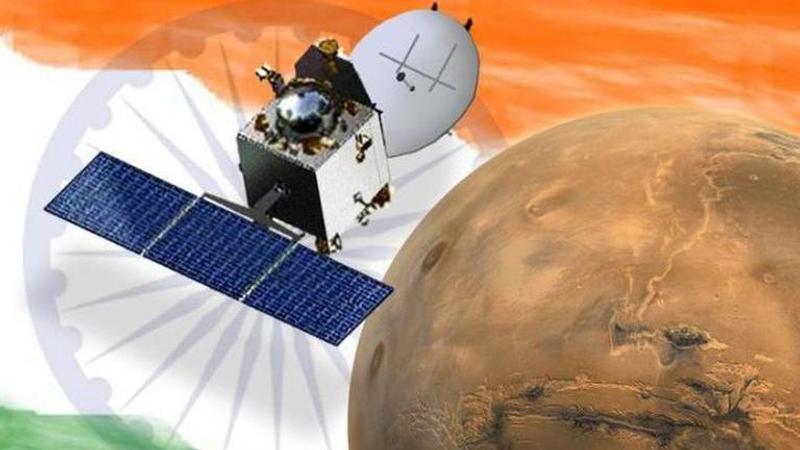Published 20:52 IST, October 2nd 2022
As ISRO's Mangalyaan bids adieu, a look back at how it began and what it accomplished
ISRO launched the Mangalyaan mission to Mars on November 5, 2013, from the Satish Dhawan Space Centre in Sriharikota on the PSLV-C25 rocket.

Officials from ISRO (Indian Space Research Organisation) confirmed on October 2 that the Mars Orbiter Mangalyaan has run out of fuel and lost connection with ground controllers. While an official statement from the agency is yet to come, it is obvious that the spacecraft has met its end after spending seven years in the Martian orbit.
Mangalyaan was India’s first Mars endeavour and it brought India on the list of countries that aced a mission to the red planet on the first attempt. As the mission has now concluded, here’s a look at its journey from Sriharikota in Andhra Pradesh all the way to Mars.
The Mangalyaan mission and its objectives
Mangalyaan lifted off from the Satish Dhawan Space Centre in Sriharikota on November 5, 2013, onboard ISRO's workhorse PSLV-C25 rocket. Officially called the Mars Orbiter Mission (MOM), ISRO says that it was just a technology demonstration as it focused on the realisation of a spacecraft capable of operating with sufficient autonomy during its journey to another planet. Orbit insertion and its proper functioning around Mars was also among the objectives.
Notably, the PSLV rocket did not have enough thrust to send the orbiter directly toward Mars, so the mission teams deployed the spacecraft's propulsion system to raise its orbit around Earth before slinging it toward the red planet.
(Mangalyaan made several orbits around Earth before setting on a Mars trajectory; Image: ISRO)
Weighing 488 kilograms, the orbiter carried five scientific payloads totalling 15 kg for the purpose of imaging Mars and studying its atmosphere. Following are five of MOM's instruments:
- MCC: Short for Mars Colour Camera, its job was to provide images and information about the surface features and composition of Mars.
- TIS: The Thermal Infrared Imaging Spectrometer was designed to map the surface composition and mineralogy of Mars.
- MSM: It's called the Methane Sensor for Mars, and as the name suggests, it was designed to measure Methane (CH4) in the Martian atmosphere and understand its origin.
- MENCA: It stands for Mars Exospheric Neutral Composition Analyser which was used to study the composition of the planet's upper atmosphere.
- LAP: Short for Lyman Alpha Photometer, it was designed to measure the relative abundance of the elements deuterium and hydrogen which would reveal more clues about how Mars lost its water.
(Mangalyaan at ISRO's facility ahead of its launch; Image:
Images sent by Mangalyaan
Roughly a year after its launch, Mangalyaan was inserted into the Martian orbit on September 24, 2014. The orbiter, which was designed to last just six months, has completed eight years. It was installed in a highly elliptical orbit around Mars, which took it over 80,000 km from the surface at the farthest point and brought it as close as 420 km. Owing to this orbit, MOM was able to take wide-angle images showcasing Mars in its entirety.
During the entire course of its lifespan, the spacecraft has sent over 1,100 images of Mars using the MCC, which takes true colour images, meaning it gives a view similar to what our naked eyes would see.
Among it images sent are some of the most breathtaking views which helped ISRO contribute to the scientific community with new discoveries. The image below shows the orbiter's view of Mars and it provides a clear distinction between the varied terrains of the planet.
(Mangalyaan's view of Mars; Image: ISRO)
(Image: ISRO)
As mentioned above, the highly elliptical orbit allowed the spacecraft to gather images from a wide angle and this vantage point made it possible to spot the water-ice caps on the poles in the image above.
(Image: ISRO)
The picture above clearly shows the gigantic dust storms which span hundreds of kilometres and can last for months. These dust storms on Mars are quite infamous as they block sunlight cutting the power supply of solar-powered rovers on the surface.
(Image: ISRO)
The MCC's photographs also feature Olympus Mons, the largest volcano in our solar system, which is clearly visible above. Almost three times bigger than Mount Everest, Olympus Mons measures 600 km in width. Interestingly, this picture also highlights the lava flows that might have occurred during eruptions in the past.
(Image: ISRO)
While all of these images are extremely intriguing, the one above tops them all as it features one of the two Martian Moon Phobos, with a thin sheath of the planet's atmosphere in the background.
What did Mangalyaan achieve?
ISRO says that the instrument MENCA detected suprathermal-- more energetic compared to thermal-- Argon in the exosphere of Mars when the orbiter was at Perihelion (point closest to Mars). Moreover, MENCA's observations also revealed for the first time that the abundance of oxygen exceeds that of carbon dioxide at an altitude of roughly 270 km during the evening hours at Perihelion. The orbiter also conducted an enhanced escape from the Martian atmosphere during a global dust storm in 2020, according to the agency.
It is worth noting, however, that ISRO's achievement in planetary exploration began even before Mangalyaan's launch as it built the spacecraft on a shoestring budget of Rs 450 crore, an amount less than what went into making science-fiction movies like 'Gravity' and 'The Martian'.
"MOM is credited with many laurels like cost-effectiveness, a short period of realisation, economical mass-budget, and miniaturisation of five heterogeneous science payloads", ISRO officials told PTI. A senior official has also revealed that considerations are in order for a second Mars mission (MOM-2), but it would need more details and international collaboration for finalisation.
Updated 22:35 IST, October 2nd 2022











